Birdfinding.info ⇒ The Eurasian form of the Long-eared Owl is numerous in Europe, but secretive and difficult to find except at winter roosts. One famous roosting site is the town center of Kikinda in northern Serbia, where up to 750 have been reported. Other Serbian towns that regularly host roosting flocks include Bašaid, Crna Bara, Melenci, Mokrin, Novi Kneževac, Opovo, Sremska Mitrovica, and Vršac. Elsewhere, sites with perennial roosts include: in Austria, Apetlon Cemetery (Neuseidler See area); in Bulgaria, Kozloduy, Krushare, and North Park (Sofia); in Czechia, Drnholec, Ołomuniec, and Uhříněves (southeast of Prague); in France, Quartier Verbeau of Châlons-en-Champagne; in Germany, Anita-Berber-Park in Berlin, Attaching (Munich airport), Langenau, and Tönning; in Hungary, Apaj (near Budapest), three villages near Hortobágyi National Park (Balmazújváros, Karcag, and Kisujszállás); in Italy, Buronzo (near Milan); in Moldova, Cimișlia; in Portugal, Castro Verde (fire station area); in Romania, Ezerets and Shabla; and in Spain, the cemetery in Corella and Cerro de San Jorge in Huesca.
“Eurasian Long-eared Owl”
Asio otus otus
Temperate woodlands of Eurasia.
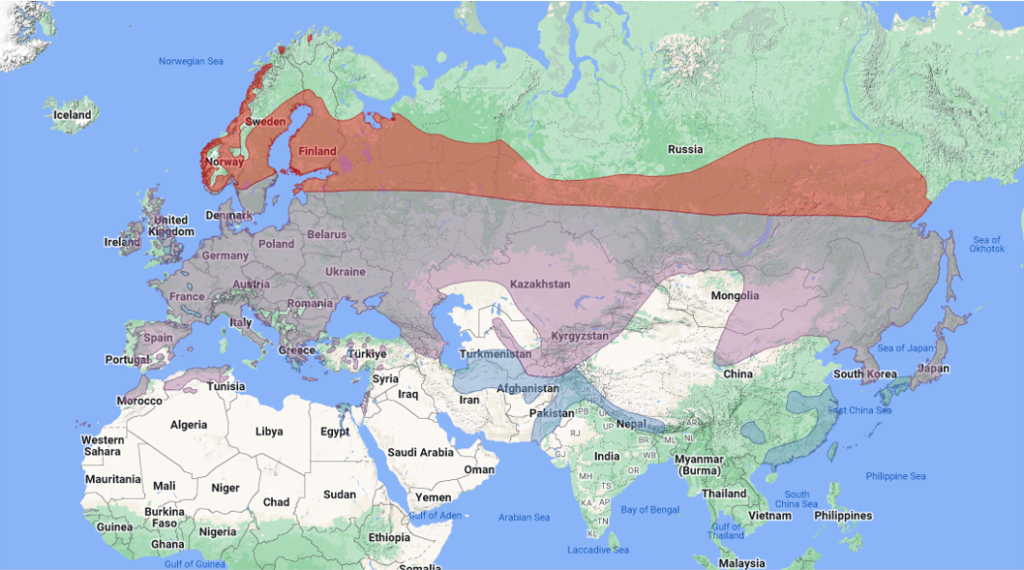
Approximate distribution of the “Eurasian Long-eared Owl”. © Xeno-Canto 2023
Breeding. Nests in various kinds of woodlands, usually in dense forest or thickets that are near open meadows, in a broad band across Eurasia. Breeds nearly throughout Europe, north to the treeline in Scandinavia and south to northern Morocco, Algeria, and Israel. Also on the Azores (all except Flores), the Canary Islands (throughout), and many of the larger Mediterranean islands.
In Asia, it breeds in most of the taiga belt from northwestern Russia east to Yakutsk, and south mainly in mountains to western and northeastern Iran, northern Afghanistan, northern India (to Himachal Pradesh), and northern China. Also on Sakhalin, Hokkaido, and northern Honshu.
Nonbreeding. Northerly breeding populations of Scandinavia and the taiga withdraw to milder climates for the winter, and most other populations move locally. The favored habitat shifts away from forests toward semi-open land, including agricultural and urban areas. Remarkably sociable on wintering grounds, typically roosting in flocks—usually from the single digits up to twenty or so, but roosts numbering in the hundreds have been reported, mainly in central Europe.
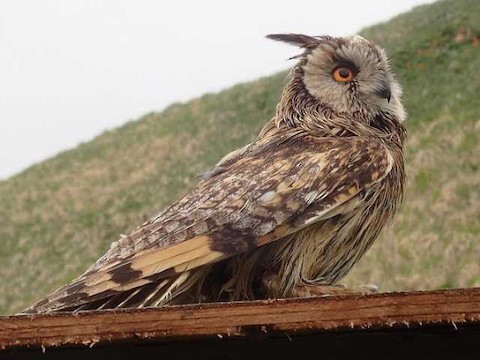
“Eurasian Long-eared Owl”, A. o. otus. (Buldir Island, Alaska; June 8, 2016.) © Mackenzie Mudge
In Europe, winters from southern Scandinavia and western Russia south to the Mediterranean region. In Asia, winters north to Kazakhstan, Mongolia, Heilongjiang, and Honshu, and regularly south to Kuwait, Rajasthan, the southern Himalayas, central China (south to Sichuan, Hubei, and Zhejiang), South Korea, and Kyushu; and irregularly south to Egypt, the U.A.E., southern Pakistan, Gujarat, southern China, Taiwan, and the Ryukyu Islands.
Movements. Occasional as a spring and fall vagrant west to the Faeroes and Iceland. Exceptional vagrants have been reported from Madeira, Western Sahara, southern Egypt, the Red Sea coast of Saudi Arabia, and Oman. Recorded twice in western Alaska: once on a boat in the northern Bering Sea; and the other on Buldir Island (June 8, 2016).
Identification
A medium-sized owl that usually appears proportionately thin, long-bodied, and long-winged. Its prominent ear-tufts are close-set, directly above its eyes, and are often raised in alarm. Mostly nocturnal, but sometimes active around dusk—and northern breeding populations are inevitably active during daylight hours.
Closely resembles the “American Long-eared Owl”, although the two forms may be better regarded as separate species.
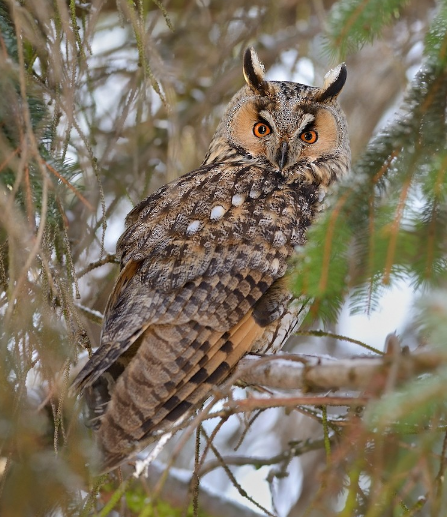
“Eurasian Long-eared Owl”, A. o. otus, typical plumage, showing vivid orange eyes. (Velké Bílovice, Jihomoravský Kraj, Czechia; January 20, 2018.) © Pavel Štěpánek
The Eurasian form differs most definitively in almost always showing orange irises, whereas the American form’s irises almost always appear bright-yellow.
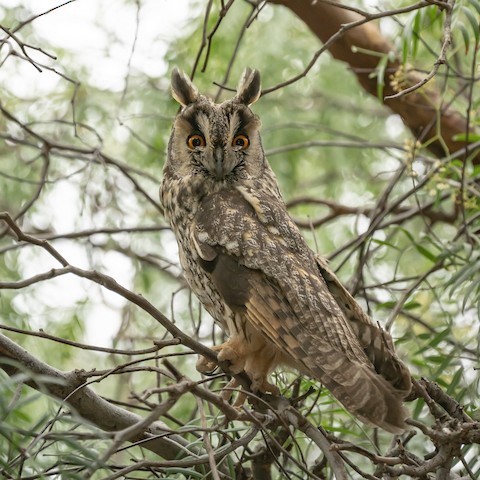
“Eurasian Long-eared Owl”, A. o. canariensis, showing relatively pale, washed-out pattern on the upperparts. (Costa Teguise, Lanzarote, Canary Islands, Spain; January 17, 2022.) © Aitor Gil Guruceaga
Their typical plumages also differ. Both forms have mostly brown, cryptically patterned upperparts. The Eurasian form is typically paler, grayer, and more uniform overall, with less heavily marked underparts—the markings on the belly typically appear as streaks without strong cross-barring. However, both forms are highly variable and the darkest Eurasian birds show coloration and markings that would be typical of the American form.

“Eurasian Long-eared Owl”, A. o. otus, showing typically streaked underparts. (Freiburg im Breisgau, Baden-Württemberg, Germany; November 18, 2017.) © Hieko Heerklotz
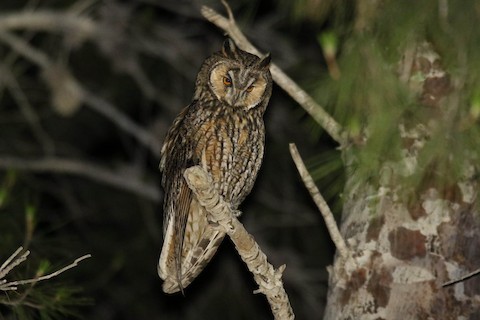
“Eurasian Long-eared Owl”, A. o. otus, a relatively dark individual with substantial cross-barring on the underparts. (Kibbutz Sde Boker, HaDarom, Israel; June 11, 2020.) © Amit Goldstein

“Eurasian Long-eared Owl”, A. o. otus, a pale individual with a pale-gray facial disk. (Maloyaroslavets, Kaluga Oblast, Russia; July 11, 2015.) © Pavel Parkhaev
The Eurasian form’s facial disk is relatively pale, usually buffy or tan, but sometimes gray (or even whitish) and sometimes orangish—exceptionally rufous or chestnut.
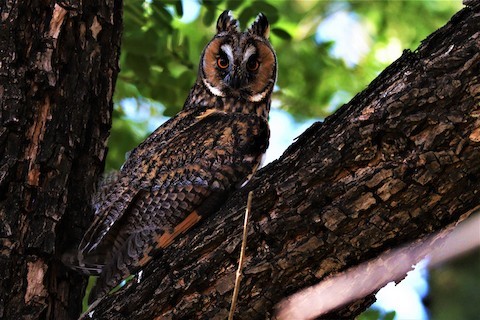
“Eurasian Long-eared Owl”, A. o. otus, an exceptionally dark individual with a rufous facial disk—much more typical of the American form, A. o. wilsonianus. (Hazor’im Reservoir, HaZafon, Israel; August 9, 2023.) © חיים ששון
Facial appearance varies significantly depending on alertness and posture. When encountered in daytime, it is typically seen in its resting posture, appearing tall and thin overall, with the facial disk narrowed and creased vertically and the ear-tufts raised vertically.

“Eurasian Long-eared Owl”, A. o. otus, with ear-tufts raised and facial disk narrowed. (Vila Franca de Xira, Portugal; October 9, 2022.) © Marcio Cachapela
When alert and active, especially when hunting, it opens its facial disk to a more circular shape and raises feather rows around the rim—which presumably enhances its ability to locate prey by sound—often showing a bright-white border. In this posture, the ear-tufts may either be raised or lowered. (When the ear-tufts are lowered, confusion with the Short-eared Owl is sometimes possible.)
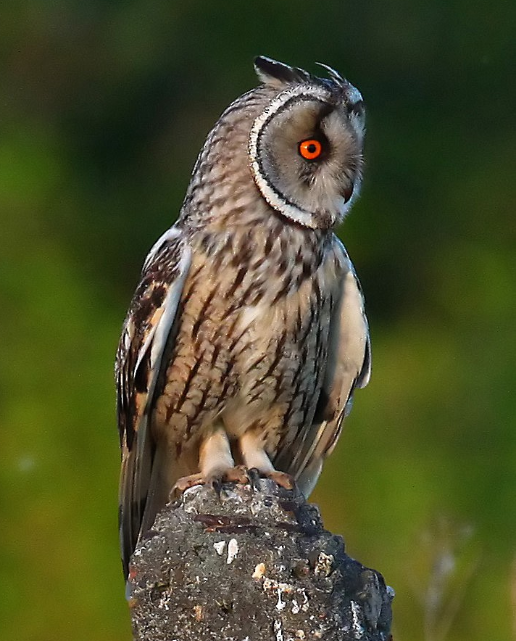
“Eurasian Long-eared Owl”, A. o. otus, with ear-tufts lowered and facial disk open and alert, showing exceptionally vivid orange eyes. (Michurinets Like, Moscow, Russia; May 24, 2011.) © Vladimir Duryabin
When seen flight, it can appear remarkably similar to a Short-eared Owl. The upperside of the wing appears mostly brown with darker bands and a prominent buffy patch in the primaries.

“Eurasian Long-eared Owl”, A. o. otus, dorsal view in flight, showing buffy patch at the base of the primaries. (Puerto del Musel, Gijón, Asturias, Spain; October 31, 2016.) © Daniel López-Velasco / Ornis Birding Expeditions
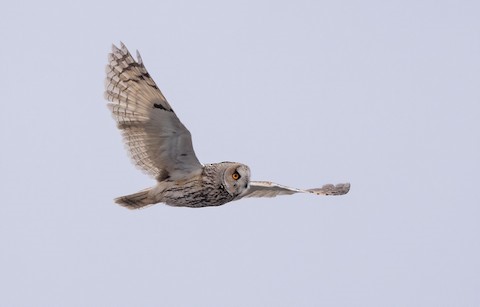
“Eurasian Long-eared Owl”, A. o. otus, showing pale underwing with a prominent black crescent at the base of the primaries, and three dark bars on the outer the primaries. (Söderskär, Emäsalo, Uusimaa, Finland; May 3, 2020.) © Matti Rekilä
The underside of the wing is mostly pale with a prominent black crescent at the base of the primaries, and two or three distinct dark bars on the outer primaries.
Voice. The male’s advertising song is a low single whoo—among the most archetypal owl calls—given at regular intervals of approximately 1.5 to 3 seconds:The Eurasian form’s typical song is lower, mellower, and more even-pitched than the American’s.
Females’ calls are more nasal and higher-pitched:
Sometimes resembling a kazoo(For a detailed review with more recordings and sonograms, see The Sound Approach: Long-eared Owl.)
Notes
Polytypic form consisting of two recognized subspecies, collectively one of two distinct forms of the Long-eared Owl (A. otus).
More Images of the “Eurasian Long-eared Owl”

“Eurasian Long-eared Owl”, A. o. otus. (Novara, Italy; December 2, 2018.) © Luigi Andena

“Eurasian Long-eared Owl”, A. o. otus, a relatively dark and reddish individual, with overall coloration and pattern more typical of the American form, A. o. wilsonianus. (Drnholec, Jihomoravský Kraj, Czechia; February 6, 2010.) © Tomáš Grim

“Eurasian Long-eared Owl”, A. o. otus, showing typically streaked underparts. (Velké Bílovice, Jihomoravský Kraj, Czechia; January 20, 2018.) © Pavel Štěpánek

“Eurasian Long-eared Owl”, A. o. otus. (Opovo, Vojvodina, Serbia; November 25, 2018.) © Roksana and Terry
References
BirdLife International. 2021. Asio otus. The IUCN Red List of Threatened Species 2021: e.T22689507A201150685. https://dx.doi.org/10.2305/IUCN.UK.2021-3.RLTS.T22689507A201150685.en. (Accessed October 17, 2023.)
Brazil, M. 2009. Birds of East Asia. Princeton University Press.
eBird. 2023. eBird: An online database of bird distribution and abundance. Cornell Lab of Ornithology, Ithaca, N.Y. http://www.ebird.org. (Accessed October 17, 2023.)
Garcia-del-Rey, E. 2011. Field Guide to the Birds of Macaronesia: Azores, Madeira, Canary Islands, Cape Verde. Lynx Editions, Barcelona.
Garcia-del-Rey, E. 2018. Birds of the Canary Islands. Christopher Helm, London.
Hollom, P.A.D., R.F. Porter, S. Christensen, and I. Willis. 1988. Birds of the Middle East and North Africa. T & AD Poyser, Calton, England.
iNaturalist. 2023. https://www.inaturalist.org/. (Accessed October 17, 2023.)
König, C., and F. Weick. 2008. Owls of the World (Second Edition). Yale University Press.
Mikkola, H. 2012. Owls of the World: A Photographic Guide. Firefly Books, London.
Mullarney, K., L. Svensson, D. Zetterström, and P.J. Grant. 1999. Birds of Europe. Princeton University Press.
Owl Pages. 2023. Long-eared Owl ~ Asio otus. https://www.owlpages.com/owls/species.php?s=3550. (Accessed October 17, 2023.)
The Sound Approach. 2019. Long-eared Owl, Asio otus. https://soundapproach.co.uk/species/long-eared-owl/.
Xeno-Canto. 2023. Long-eared Owl – Asio otus. https://xeno-canto.org/species/Asio-otus. (Accessed October 17, 2023.)
